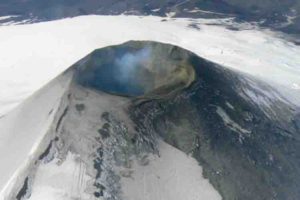
A new study has shown that monitoring inaudible low frequencies called infrasound produced by a type of active volcano could improve the forecasting of significant, potentially deadly eruptions.
Scientists from Stanford and Boise State University analyzed the infrasound detected by monitoring stations on the slopes of the Villarrica volcano in southern Chile, one of the most active volcanoes in the world. The distinctive sound emanates from the roiling of a lava lake inside a crater at the volcano’s peak and changes depending on the volcano’s activity.
The study demonstrated how changes in this sound signaled a sudden rise in the lake level, along with rapid up-and-down motions of the surging lake near the crater’s rim just ahead of a major eruption in 2015. Tracking infrasound in real time and integrating it with other data, such as seismic readings and gas emission, might help alert nearby residents and tourists that a volcano is about to blow its stack, the researchers said.
“Our results point to how infrasound could aid in forecasting volcanic eruptions,” said study co-author Leighton Watson, a graduate student in the lab of Eric Dunham, an associate professor in the Department of Geophysics of the Stanford School of Earth, Energy & Environmental Sciences and also a co-author. “Infrasound is potentially a key piece of information available to volcanologists to gauge the likelihood of an eruption hours or days ahead.”
The study, published Feb. 14 in the journal Geophysical Research Letters, is led by Jeffrey Johnson, an Associate Professor of Geophysics at Boise State University in Idaho.
Sleeping giant roars awake
Villarrica is a picturesque mountain with an altitude of 9,300 feet. The snowcapped volcano looms over a lake and across from the city of Pucón, which swells to a quarter million people in the summer tourist season. At night, residents of Pucón can often see a scarlet glow from Villarrica’s lava lake, normally hidden well below the volcano’s rim.
The ominous serenity that had held at Villarrica since its last eruption in the mid-1980s ended in the early morning hours on March 3, 2015. An incandescent fountain of lava rocketed from the mountaintop nearly a mile into the sky, spewing ash and debris and triggering bolts of lightning from the thick heat-generated clouds enveloping the summit. Around 4,000 people evacuated the immediate area. The eruption proved short-lived, however, and with risks of mudslides and flooding from melted snow minimal, evacuees soon returned to their homes.
Infrasound monitoring stations established at Villarrica just two months before the 2015 event and maintained by co-author Jose Palma from the University of Concepcion in Chile captured its before-and-after sonic activity. Studying these data, the research team saw that in the build-up to the eruption, the pitch of the infrasound increased, while the duration of the signal decreased. Flyovers in aircraft documented the changes in Villarrica’s lava lake, allowing researchers to explore connections between its height and the sound generation.
Watson offered a music analogy to explain this relationship. Similar to a person blowing into a trombone, explosions from gas bubbles rising and then bursting at the surface of the lava lake create sound waves. Just as the shape of a trombone can change the pitch of the notes it produces, the geometry of the crater that holds the lava lake modulates its sounds. When the lava lake is deep down in the volcano’s crater, the sound registers at a lower pitch or frequency — “just like when a trombone is extended,” said Watson. When the lava lake rises up in the crater, potentially heralding an eruption, the pitch or frequency of the sound increases, “just like when the trombone is retracted,” said Watson.
Warning signs
Future research will seek to tie infrasound generation to other critical variables in volcano monitoring and eruption forecasting, such as seismicity. Ahead of an eruption, seismic activity in the form of small earthquakes and tremors almost always increases. This seismicity emanates from several miles underground as magma moves through the volcano’s “plumbing system” of fractures and conduits that connect the volcano’s opening to magma chambers in our planet’s crust. Volcanologists think that changes in lava lake levels — and their attendant infrasound — result from the injection of new magma through volcanic plumbing, increasing the odds of a violent outburst.
In this way, the collection of infrasound should prove beneficial for forecasting purposes at “open vent” volcanoes like Villarrica, where an exposed lake or channels of lava connect the volcano’s innards to the atmosphere. Closed vent volcanoes, however, where the pooling magma remains trapped under rock until an explosive eruption occurs, do not generate the same kind of infrasound and thus pose additional forecasting challenges. An example of a closed vent volcano is Mount St. Helens in southwestern Washington state, whose eruption in 1980 remains the most lethal and destructive eruption in the history of the United States.
“Volcanoes are complicated and there is currently no universally applicable means of predicting eruptions. In all likelihood, there never will be,” Dunham said. “Instead, we can look to the many indicators of increased volcanic activity, like seismicity, gas emissions, ground deformation, and — as we further demonstrated in this study — infrasound, in order to make robust forecasts of eruptions.”
Reference:
Jeffrey B. Johnson, Leighton M. Watson, Jose L. Palma, Eric M. Dunham, Jacob F. Anderson. Forecasting the eruption of an open-vent volcano using resonant infrasound tones. Geophysical Research Letters, 2018; DOI: 10.1002/2017GL076506
Note: The above post is reprinted from materials provided by Stanford’s School of Earth, Energy & Environmental Sciences.









